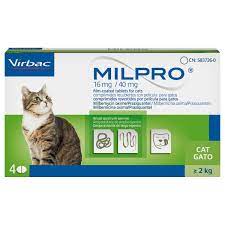Milpro film-coated tablets for Cats and Kittens Species: Cats Therapeutic indication: Pharmaceuticals: Endoparasiticides: Anthelmintics for cats, Tapeworm products Active ingredient: Milbemycin Oxime, Praziquantel Product:Milpro film-coated tablets for cats and kittens Product index: Milpro film-coated tablets for cats and kittens Qualitative and quantitative composition Milpro 4mg/10mg for small cats and kittens: Each tablet contains as active substances: Milbemycin oxime 4mg and Praziquantel 10mg Milpro 16mg/40mg for cats: Each tablet contains as active substances: Milbemycin oxime 16mg and Praziquantel 40mg Pharmaceutical form Oval shaped, film coated, meat flavoured tablets with a score on both sides. Tablets can be divided into halves. Milpro 4mg/10mg for small cats and kittens are dark brown. Milpro 16mg/40mg for cats are red to pink. Clinical particulars Target species Cats Indications for use In cats: treatment of mixed infections by immature and adult cestodes (tapeworms) and adult nematodes (roundworms) of the following species: Cestodes: Echinococcus multilocularis Dipylidium caninum, Taenia spp., Nematodes: Ancylostoma tubaeforme, Toxocara cati Prevention of heartworm disease (Dirofilaria immitis), if concomitant treatment against cestodes is indicated. Contra-indications Milpro for small cats and kittens: Do not use in kittens of less than 6 weeks of age and/or weighing less than 0.5 kg. Milpro for cats: Do not use in cats weighing less than 2kg Do not use in cases of hypersensitivity to the active substances or to any of the excipients. Special warnings for each target species It is recommended to treat all the animals living in the same household concomitantly. In order to develop an effective worm control programme local epidemiological information and the living conditions of the cat should be taken into account and therefore it is recommended to seek professional advice. Parasite resistance to any particular class of anthelmintic may develop following frequent, repeated use of an anthelmintic of that class. When D. caninum infection is present, concomitant treatment against intermediate hosts, such as fleas and lice, should be considered to prevent re-infection. Special precautions for use Special precautions for use in animals No studies have been performed with severely debilitated cats or individuals with seriously compromised kidney or liver function. The product is not recommended for such animals or only according to a benefit/risk assessment by the responsible veterinarian. Studies have shown that treatment of dogs with a high number of circulating microfilariae can sometimes lead to the appearance of hypersensitivity reactions, such as pale mucous membranes, vomiting, trembling, laboured breathing or excessive salivation. These reactions are associated with the release of proteins from dead or dying microfilariae and are not a direct toxic effect of the product. The use in dogs suffering from microfilaremia is thus not recommended. In the absence of data on cats with microfilaraemia, its use should be according to a benefit risk assessment by the attending veterinarian. As the tablets are flavoured, they should be stored in a safe place out of the reach of animals. As per good veterinary practice, animals should be weighed to ensure accurate dosing. Ensure cats and kittens weighing between 0.5 kg and ≤2 kg receive the appropriate tablet strength (4 mg MBO/10 mg praziquantel) and the appropriate dose (1/2 or 1 tablet) for the corresponding weight band (1/2 tablet for cats weighing 0.5 to 1 kg ; 1 tablet for cats weighing >1 to 2 kg – 1 tablet). Special precautions to be taken by the person administering the veterinary medicinal product to animals Wash hands after use. Part tablets should be returned to the open blister pack and stored in the carton. In the event of accidental ingestion of the tablets, particularly by a child, seek medical advice immediately and show the package leaflet or the label to the doctor. Other precautions Echinococcosis represents a hazard for humans. As Echinococcosis is a notifiable disease to the World Organisation for Animal Health (OIE), specific guidelines on the treatment and follow-up, and on the safeguard of persons, need to be obtained from the relevant competent authority. Adverse reactions In very rare occasions, especially in young cats, hypersensitivity reactions, systemic signs (such as lethargy), neurological signs (such as ataxia and muscle tremors) and/or gastrointestinal signs (such as emesis and diarrhoea) may be observed after administration of the veterinary medicinal product. Use during pregnancy, lactation or lay In a study, this combination of active substances was demonstrated to be well tolerated in breeding queens, including during pregnancy and lactation. As a specific study with this product has not been performed, use during pregnancy and lactation only according to a benefit/risk assessment by the responsible veterinarian. Interactions The concurrent use of the combination praziquantel/milbemycin oxime with selamectin is well tolerated. No interactions were observed when the recommended dose of the macrocyclic lactone selamectin was administered during treatment with the combination at the recommended dose. In the absence of further studies, caution should be taken in the case of concurrent use of the product and other macrocyclic lactones. Also no such studies have been performed with reproducing animals Amounts to be administered and administration route Oral use. As per good veterinary practice, animals should be weighed to ensure accurate dosing. Minimum recommended dose rate: 2 mg of milbemycin oxime and 5 mg of praziquantel per kg are given orally as a single dose. The product should be administered with or after some food. The product is a small size tablet. To aid with administration, the product has been coated with a meat flavour. The tablets can be divided into halves. Depending on the bodyweight of the cat, the practical dosing is as follows: Weight Tablets Milpro 4mg/10mg for small cats and kittens 0.5 - 1 kg ½ tablet >1 - 2 kg 1 tablet Milpro 16mg/40mg for cats 2 - 4 kg ½ tablet >4 - 8 kg 1 tablet >8 - 12 kg 1 ½ tablets In cases when heartworm disease prevention is used and at the same time treatment against tapeworm is required, the product can replace the monovalent product for the monthly prevention of heartworm disease. Overdose In a study conducted with the product administered at 1X, 3X and 5X the therapeutic dose, and for a duration which exceed the therapeutic indication, i.e. 3 times at 15 day-intervals, signs uncommonly reported at the recommended dose (see section 4.6) have been observed at 5-fold the therapeutic dose after the second and third treatments. These signs disappeared spontaneously within a day. Withdrawal periods Not applicable Pharmacological particulars Pharmacodynamic properties Milbemycin oxime belongs to the group of macrocyclic lactones, isolated from the fermentation of Streptomyces hygroscopicus var. aureolacrimosus. It is active against mites, against larval and adult stages of nematodes as well as against larvae of Dirofilaria immitis. The activity of milbemycin is related to its action on invertebrate neurotransmission: Milbemycin oxime, like avermectins and other milbemycins, increases nematode and insect membrane permeability to chloride ions via glutamate-gated chloride ion channels (related to vertebrate GABAα and glycine receptors). This leads to hyperpolarisation of the neuromuscular membrane and flaccid paralysis and death of the parasite. Praziquantel is an acylated pyrazino-isoquinoline derivative. Praziquantel is active against cestodes and trematodes. It modifies the permeability for calcium (influx of Ca2+) in the membranes of the parasite inducing an imbalance in the membrane structures, leading to membrane depolarisation and almost instantaneous contraction of the musculature (tetany), rapid vacuolization of the syncytial tegument and subsequent tegumental disintegration (blebbing), resulting in easier expulsion from the gastrointestinal tract or death of the parasite. Pharmacokinetic properties In the cat, praziquantel reaches peak plasma concentrations within 1-4 hours after oral administration. The half life of elimination is around 3 hours. In the dog, there is rapid hepatic biotransformation, principally to monohydroxylated derivatives. The principal route of elimination in the dog is renal. After oral administration in the cat, milbemycin oxime reaches peak plasma concentrations within 2-4 hours. The half life of elimination is around 32 to 48 hours. In the rat, metabolism appears to be complete although slow, since unchanged milbemycin oxime has not been found in urine or feces. Main metabolites in the rat are monohydroxylated derivatives, attributable to hepatic biotransformation. In addition to relatively high liver concentrations, there is some concentration in fat, reflecting its lipophilicity



